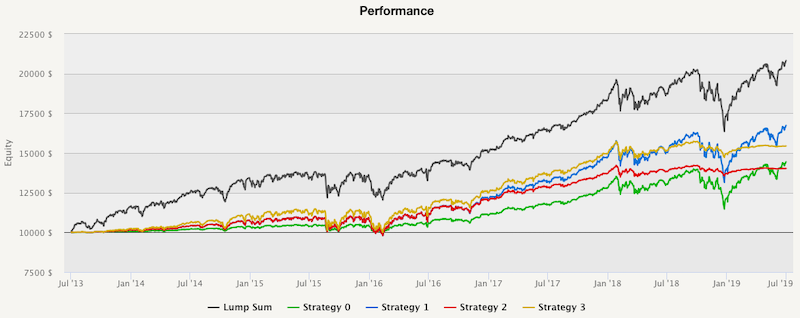Don’t know exactly how to use our tools? Read our Quantpedia Answers series, which will give you a manual and responses to the most frequently asked questions through brief and clear instructions.
Should I invest all at once or in parts?
1. First, we need to answer the question of what are the risks and benefits of investing all at once. If you obtain a large amount of money and invest it all at once in a so-called “lump sum investment,” you risk losing a lot if an unexpected bear market comes. But, on the other hand, you gain a lot if the market goes up.
2. An alternative to the lump sum investment is a strategy called Dollar Cost Averaging (DCA). The most significant advantage of DCA is diversification. When applying DCA, you divide your investment across multiple timeframes regardless of the market conditions. If you start investing and the market starts to fall, you have an advantage. The chances are that if you divide your investment into enough parts – the market will not be falling once you finish your partial investments. You may even buy at a lower average price compared to the one-time investment.
3. We are going to present two examples. The first one will show a period where DCA is a suitable option. And another one, where investing in a lump sum is a better idea.
To illustrate the examples, we are using the Dollar Cost Averaging tool from Portfolio analysis. This tool compares four DCA strategies with a lump sum investment:
-
-
- Strategy 0: invests the same amount into your model portfolio every month
- Strategy 1: invests periodically only during the first half of the period and then just holds the entire investment till the end of the period
- Strategy 2: invests periodically during the first half of the period, and it divests during the second half
- Strategy 3: invests periodically during the first third of the period, then holds the investment during the second third, and lastly divests on a monthly basis during the last third of the period
-

4. Example of a good period for DCA strategy:
The 6-year period from 1. July 2007 till 1. July 2013 was a really great one for all of our DCA strategies. Splitting the investments during the 2008 crisis was a huge advantage. All of the risk and return characteristics of DCA strategies outperformed the lump sum investment.


5. Example of a bad period for DCA strategy:
The 6-year period right after the period from the first example was a really low performing one for DCA strategies. The lump sum investment rose very quickly because the market started to recover from the recession. However, the volatilities of the DCA strategies were still lower compared to the lump sum investment.


6. Overall, there the answer to this question depends on the market conditions. If you expect the market to fall, it is better to apply DCA. On the other hand, it is preferable to invest in a lump sum if you expect the market to rise. The last chart simulates rolling 5-year periods to see how DCA strategies perform compared to Lump Sum at different points in time.


